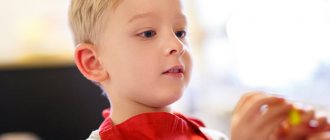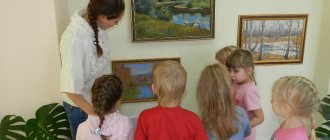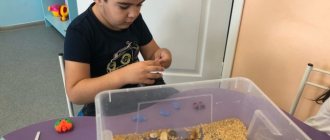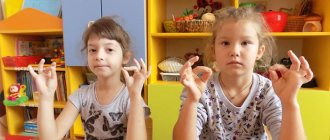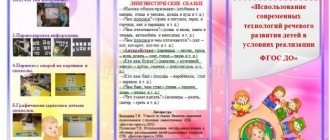What it is?
In pedagogy, the artistic and aesthetic development of a preschooler is understood as the formation of the ability to perceive the beauty of the surrounding world, as well as the development of the ability to show creative activity.
These qualities are developed in a child already in preschool age.
Artistic and aesthetic development performs the following tasks:
- Develops the emotional sphere of the child’s inner world.
- Helps accumulate aesthetic knowledge and standards.
- Forms the ability to enjoy aesthetic objects, as well as express one’s own attitude towards them.
- Develops abilities in the creative field.
These goals are achieved through various forms and types of aesthetic development.
Conversations are held with preschoolers on topics about the sublime and beautiful.
Communication with nature, which is an inexhaustible source of beauty, plays a big role.
In addition, it is important how the space in which children are is organized; it also has educational significance.
Preschoolers directly participate in a variety of creative activities - drawing, dancing, music, crafts, etc. In holidays and games, children embody artistic ideas that they became acquainted with during the learning process.
There are various forms of organizing artistic and aesthetic development:
- Games.
- Training sessions.
- Exhibitions.
- Excursions.
- Holidays.
IMPORTANT! It is necessary to select the form and type of activity in the artistic and aesthetic sphere in accordance with the age and interests of the students. The goals that the teacher strives for should be taken into account.
Goals and objectives
In the course of teaching activities, educators solve the following tasks:
- Helps the child develop aesthetic perception.
- Form an idea of aesthetics.
- Develop artistic and creative abilities.
- Form aesthetic taste.
The purpose of this training is to introduce the child to the world of art. He develops elementary ideas about its varieties. Children develop the prerequisites for value-semantic perception.
Activities to develop abilities in preschool age
There is a huge variety of creative activities that contribute to the development of artistic perception of preschoolers, who vary in age and type of creativity.
Classes for 3-4 years
REFERENCE! At this age, babies are just learning to express a positive reaction when they see familiar objects. They are not yet ready to perceive an artistic image, but choose certain pictures simply because they like them or resemble familiar objects.
One of the effective ways to develop artistic and aesthetic skills in children of primary preschool age is unconventional drawing. This provides an incentive to develop the ability to think outside the box and experiment. The arsenal of unconventional drawing is very diverse:
- Drawing with stencils - in this case, paint is applied to a pre-prepared stencil using a variety of tools: a sponge, a brush, a roller or even ordinary rags.
- Drawing with stamps, palms, leaves, cotton swabs, etc. - in this case, paint is applied to a stamp or something that replaces it and an impression is made on paper. Prints can be formed into patterns, and you can experiment with color.
- Drawing on wet paper differs from regular drawing in that paint is applied to a pre-moistened sheet and it spreads, creating unexpected patterns. At the same time, the child learns to follow what happens and guide the drawing process.
Modeling from plasticine not only forms artistic and aesthetic perception, but also promotes the development of fine motor skills, which is very important in preschool age. To deepen the effect of these activities, plasticine figures sculpted by children are used to dramatize fairy tales.
IMPORTANT! Musical classes can be either an independent form of creativity or accompany the creative process in other directions. For example, when a teacher turns on music while drawing or sings songs with children while dramatizing fairy tales.
Classes for 5-7 years old
REFERENCE: At the age of 5, a child is already able to receive aesthetic pleasure from contemplating a painting, but for him the color scheme is more important than the composition. At the age of 6-7 years, perception becomes much more subtle, children capture the inner mood of the image.
At this age, the possibilities for creative activities with children expand, as the children’s abilities also expand.
Older preschoolers have more complex skills and can complete more complex tasks.
For example, children 6-7 years old can engage in floristry, quilling, papermaking, etc.
Floristry is the creation of compositions from plant materials. It requires the child to be able to see the image, select the necessary shapes and shades of colors, and carefully work with fragile material.
For work, you can use leaves, flowers, twigs, moss and other plant materials.
Quilling is the making of pictures from rolled strips of paper. This is a rather painstaking task that requires patience and perseverance. Artistically, children learn to compose a composition and select colors.
Papermaking is an excellent tool for developing imaginative thinking. By making three-dimensional models from paper, preschoolers solve design problems, show imagination and aesthetic taste. Additionally, paper craft activities can be complemented by storytelling, drama, and other forms of creative development.
IMPORTANT! In older preschool age, children begin to get acquainted with the masterpieces of world artistic culture - paintings, architecture, literature (fairy tales, poems), etc. This happens in the form of conversations, viewing photographs, and reading.
Recommendations for teachers and educators
Recommendations for the moral and aesthetic education of preschoolers include a number of methods and principles:
- Aesthetics of the environment (live plants, furniture, color scheme for playrooms, cleanliness and order).
- Independent artistic activity (classes in free creativity using decorative and applied arts).
- Classes with a teacher (development of tastes and ideals under the supervision and sensitive guidance of a mentor).
There are some features of aesthetic education of preschool children in preschool educational institutions. Unlike the home environment, creative activity takes place among peers and under the guidance of a competent mentor. This motivates the child to do everything better so that he is praised and distinguished from the rest. If at home a child often gives up at the first failure, then in kindergarten, looking at the example of other children, he will look for ways to cope with the task. Therefore, creative and aesthetic activities should be carried out precisely in preschool educational institutions.
To do this, the teacher must clearly understand what creativity is and what competencies and skills the child should acquire as a result.
Indicators of creative activity (according to I. Lerner):
- the ability to use old knowledge in a new situation without outside help;
- the ability to find and apply new functions of an already known object;
- the ability to see problems in a standard situation;
- the ability to combine previously known methods into new ones.
The teacher should encourage the child for showing independence, and in no case scold if the children, for example, start drawing a bouquet instead of one flower. What is important is a relaxed atmosphere and some relaxation of discipline - let the preschoolers talk, go to the window or stand with toys. Then the aesthetic education of preschoolers will be carried out with joy and inspiration for the child.
Features of the development of technical creativity in preschool children
Technical creativity teaches a preschool child not only perseverance and patience, but also helps to develop certain abilities:
- The ability to find non-standard solutions to the tasks assigned to them and select a means for these solutions.
- Plan your activities.
- Compare, find differences and similarities, generalize.
- Select parts and combine them into a whole.
- Analyze your actions step by step, draw conclusions, give an account of your actions, assume further options for the development of events, correct shortcomings, identify advantages and use them in the future.
The importance of didactic games for the preparatory group
In addition, preschoolers learn to interact with each other, gain experience working in a team, learn to negotiate, look for a way out of the current situation, and develop their imagination.
Note ! The main type of activity of a preschooler according to the Federal State Educational Standard is play, which is inextricably linked with a toy. One follows from the other: a toy gives rise to play activity, and by developing play activity, it attracts new toys. Therefore, it is better to engage in technical creativity with little ones through play. The game helps to captivate the preschooler, interest him and achieve the desired result.
The best option for technical creativity of kids are:
- magnetic constructors;
- building kits;
- various cubes;
- block constructors;
- modeling kits;
- constructors with joint fastening;
- bolt-on constructors.
Examples of activities with preschoolers
Aesthetic education of preschoolers is a process organized by a teacher or parents. They use not only a theoretical basis, but also a practical one. Children are engaged in reading fiction, looking at pictures, and also creating objects of art.
Integrated lesson “Fairytale Bird”
Initially, children are introduced to a work about a fairy-tale bird. You can use fiction about the Firebird. The children are read fairy tales and shown pictures describing a magical creature.
Integrated lesson “Fairytale Bird” (application)
Integrated lesson “Fairytale Bird” (plasticine)
After this, they talk with the children. They ask you to give a description of the bird. Children who find it difficult to make contact are asked leading questions. For example, “What color are her feathers?” After the children appreciate the attractiveness of the character, they are invited to make their own Firebird.
Depending on the age of the children, they are given paints or pencils. You can use plasticine. After the material has been distributed, the children are allowed to use their imagination and make their own crafts.
Application “Decorating dishes”
This activity contributes to the development of the child’s creative abilities and develops his sense of beauty. During the activity, perseverance is developed and accuracy is demonstrated.
The teacher prepares handouts in advance:
- Templates for mugs and plates – to choose from.
- Carves patterns or ornaments.
- Selects demonstration material.
This activity can be added to the cycle about folk art. Before practice, children are told about how in the old days it was customary to paint dishes. What significance was attached to patterns? As an example, photographs of folk art are shown.
After theory, they begin practice. Each child is given a piece of utensils and asked to decorate it based on personal taste.
The activity “Decorating dishes” can also be done with plasticine
Draw children's attention to neatness, conciseness of details, and selected colors. You can correct the child a little during work, offer him parts that match the color. At the end of the lesson, they admire the created creations.
Craft for March 8th “Bouquet for Mom”
This activity is suitable both as a creative master class and as an opportunity to make a craft for a specific holiday. To hold the event you will need preliminary preparation. It is necessary to select the material from which children will create bouquets. These can be buttons, scraps of fabric, colored paper, ribbons.
The easiest way to make a bouquet:
- Use colored paper clippings.
- Prepare beautiful templates.
For work, the teacher cuts out beautiful flowers from paper. Be sure to draw the outlines of the plants on a blank sheet of paper so that the child can see where to stick the blank. Before starting practical activities, the teacher tells the children the theoretical foundations. After this he distributes the material.
It is advisable to do finger exercises and then start creating crafts.
Creating a still life
First, children are introduced to this type of art in painting as still life.
Paintings by outstanding artists are on display:
- “Rowanka”, Mashkov I. I.
- “Cornflowers”, Levitan I. I.
- "Base with Fruit", Picasso P.
First, the teacher prepares templates with an empty fruit vase. After the children have become familiar with the still lifes, the teacher shows them a blank sheet. He says that there is not enough fruit in the image, because of this the still life does not work.
Children must add fruit to the template with the vase. Use pencils, paints or wax crayons.
